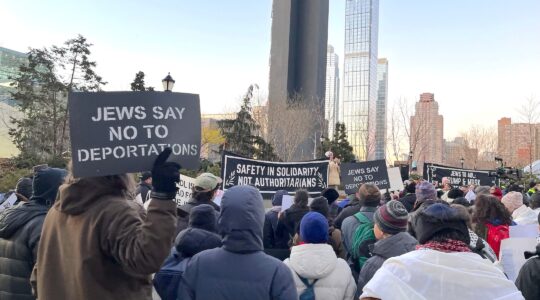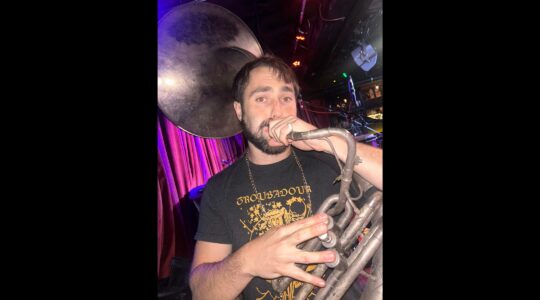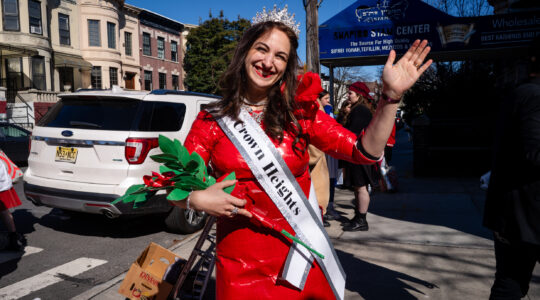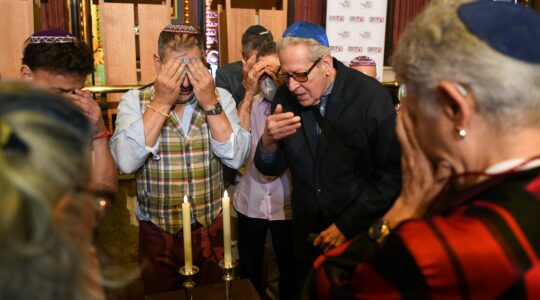The Workmen’s Circle/Arbeiter Ring started more than a century ago in a tenement on the Lower East Side. It developed over the decades from a mutual-aid society for immigrants into an activist organization bristling with radical ideologies and aimed at promoting secular Jewish education. Next week, the group marks the start of its second century with a celebration of Yiddish culture at Town Hall.
Acts who have made Yiddish part of their shtick — Mandy Patinkin, Theodore Bikel, Tovah Feldshuh and the Klezmatics — are set to perform in the Circle’s 100th anniversary benefit concert on Nov. 6. Sholem Aleichem’s granddaughter, Bel Kaufman, takes the stage with “Fiddler on the Roof” creator Sheldon Harnick to discuss the great Yiddish author and the adaptation of his book “Tevye the Dairyman” into the musical that introduced Yiddishkeit into American homes. Choruses from four cities will sing immigrant anthems and songs from the Jewish labor movement’s more muscular days, ending with a Yiddish version of Beethoven’s “Ode to Joy.”
The program shows ways that “Yiddish has had its effect on American society, and how the Workmen’s Circle, by having Yiddish strongly in its mission, has maintained that,” says Zalman Mlotek, who conducts the event’s choral conglomeration. The son of prominent Circle activists, Mlotek is executive director of the Folksbiene, the country’s predominant Yiddish-language theater company, which started in 1915 as a local branch of the Workmen’s Circle. (See review of Folksbiene’s new show on page 43.)
Circle officials expect a full house at Town Hall, itself a monument to the triumph of social action. (It was built in 1921 as a meeting house by a group of suffragettes.) But looking ahead, the Workmen’s Circle — which once required members to join trade unions and vote for working-class parties — faces a challenge common among Jewish groups: how to carry its mission of promoting progressive Jewish, and especially Yiddish, culture into a new generation.
“To be honest, probably not that many people in my circle of friends are going to be major labor-movement activists,” says Jessica Rich, 29, a 15-year alumna of Camp Kinder Ring, the upstate summer camp where, Circle officials say, 600 campers summer annually. That rich source of new membership has yet to be vigorously mined — as does the network of 10 supplemental schools, called “shuln,” in five states, where curricula cover Jewish culture, history, ethics and the Yiddish language.
At its peak in 1925, the Circle had 87,000 members, up from 6,776 in 1905, according to the American Jewish Historical Society. Today, the number falls between 40,000 and 50,000 “members, supporters and participants,” says executive director Robert Kestenbaum.
But Rich remains sanguine about prospects among her peers. “If you sat enough people down and made them figure out what they want from their Jewish identity, the secular option is going to be attractive,” she said.
The Workmen’s Circle was founded in 1892 and became a national order in 1900. Unlike the landsmanschaftn, the expatriate societies established according to native regions in Eastern Europe, the Circle’s members were united around a shared secular, political ideology. They aimed to provide “sick benefits” and other assistance to immigrant-workers’ families and to support the labor and socialist movements around the world.
After 1905, an influx of immigrants brought with it members of the Bund, who combined socialist theory with social action. The Bundists pressed for the promotion of Yiddish culture, and the Circle established cultural activities to advance it, publishing books and setting up adult education. Other initiatives begun early last century are still in evidence today: the shuln, homes for the aged, the summer camp, choruses and member benefits.
Although its fight seems less fierce these days, the Circle persists in promoting a social-justice agenda consistent with its roots. In 2002 the group came out against sweatshop and child labor, and for gun control and the decriminalization of drugs, among resolutions on a dozen topics.
Kestenbaum, who started with the Circle as a clerk in its medical clinic, acknowledged that the centennial hoopla is two years past due. “Basically,” he said, “it’s an endless kind of thing.” This month’s celebration “is really a continuation of something that [started] in 1900.”
That staying power impresses younger members. “You feel like you’re part of 100 years of people closer to the street, 100 years of people who made a difference to their constituency,” says Rich, who joined the Circle’s board in June and serves alongside her grandfather Harold Ostroff.
Ostroff, a past president of the Workmen’s Circle and the former general manager of the Forward Association will be honored at the Nov. 6 event, as will Bernard Nussbaum, a former White House Counsel, and Judith Vladeck, an attorney and advocate for labor and employment rights for women. Senators Barbara Boxer, Hillary Clinton and Charles Schumer, as well as Sandra Feldman, president of the American Federation of Teachers, are the event’s honorary chairs.
“Yiddish in America” takes place at Town Hall, 123 W. 43rd St., Man., (212) 889-6800, Ext. 300 or (212) 307-4100. Wed., Nov. 6, 7:30 p.m. Tickets are $250, $100, $50 and $36. “Here and Now,” an exhibition on the Jewish Labor Bund in interwar Poland is on view through Dec. 31 at the YIVO Institute for Jewish Research, 15 W. 16th St., Man., (212) 294-8301. Mon.-Thurs., 9:30 a.m.-5 p.m.
The New York Jewish Week brings you the stories behind the headlines, keeping you connected to Jewish life in New York. Help sustain the reporting you trust by donating today.




